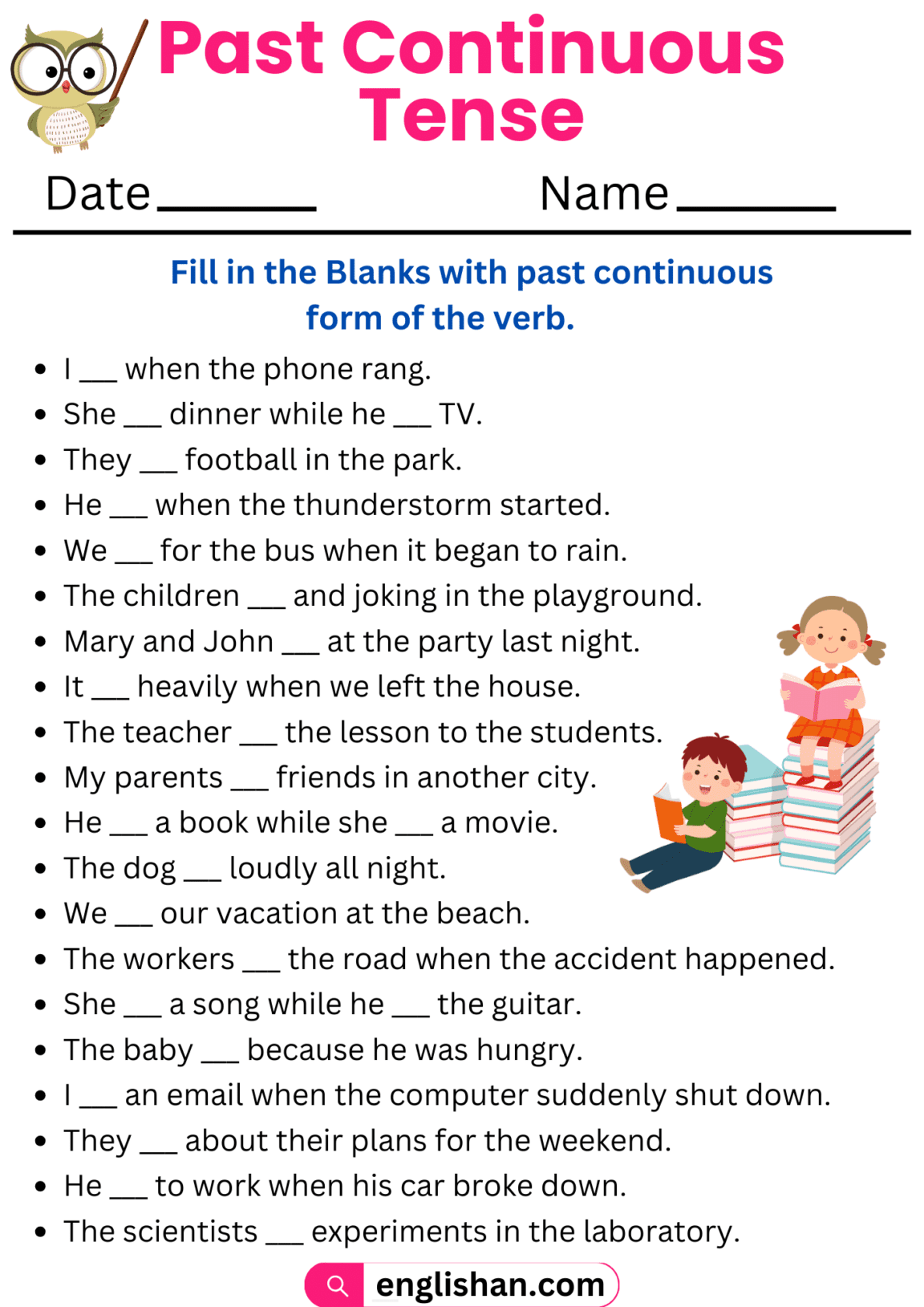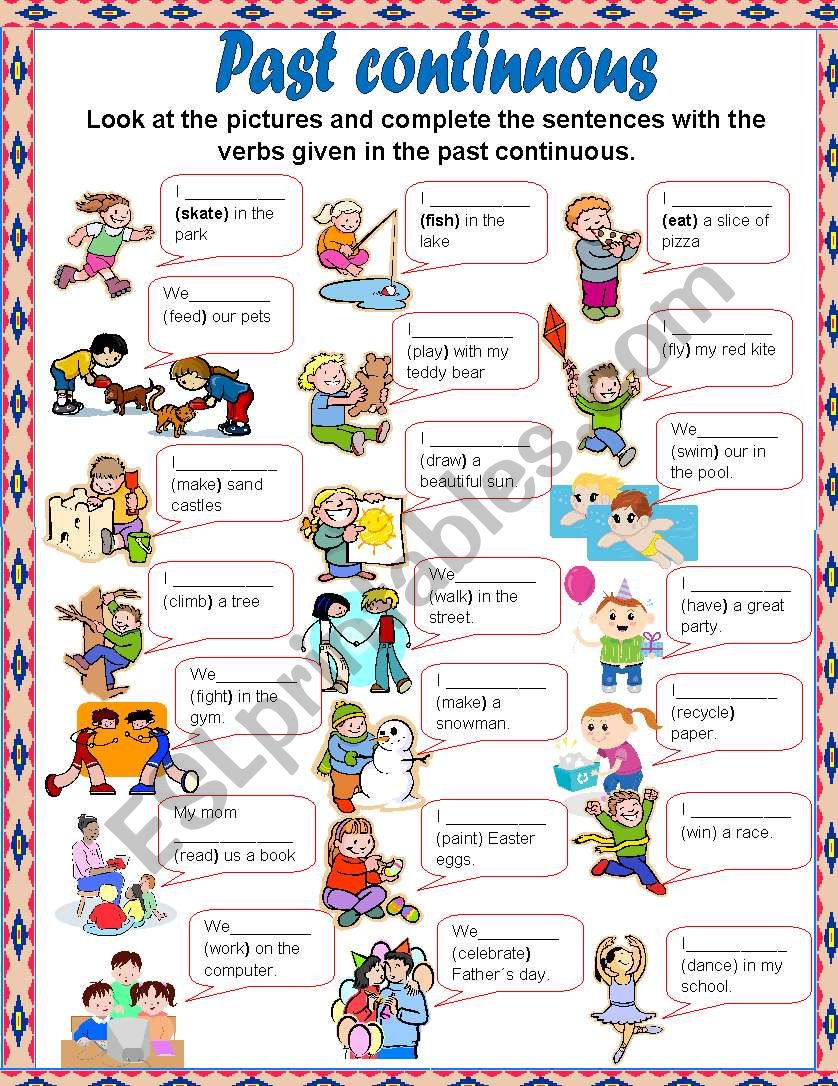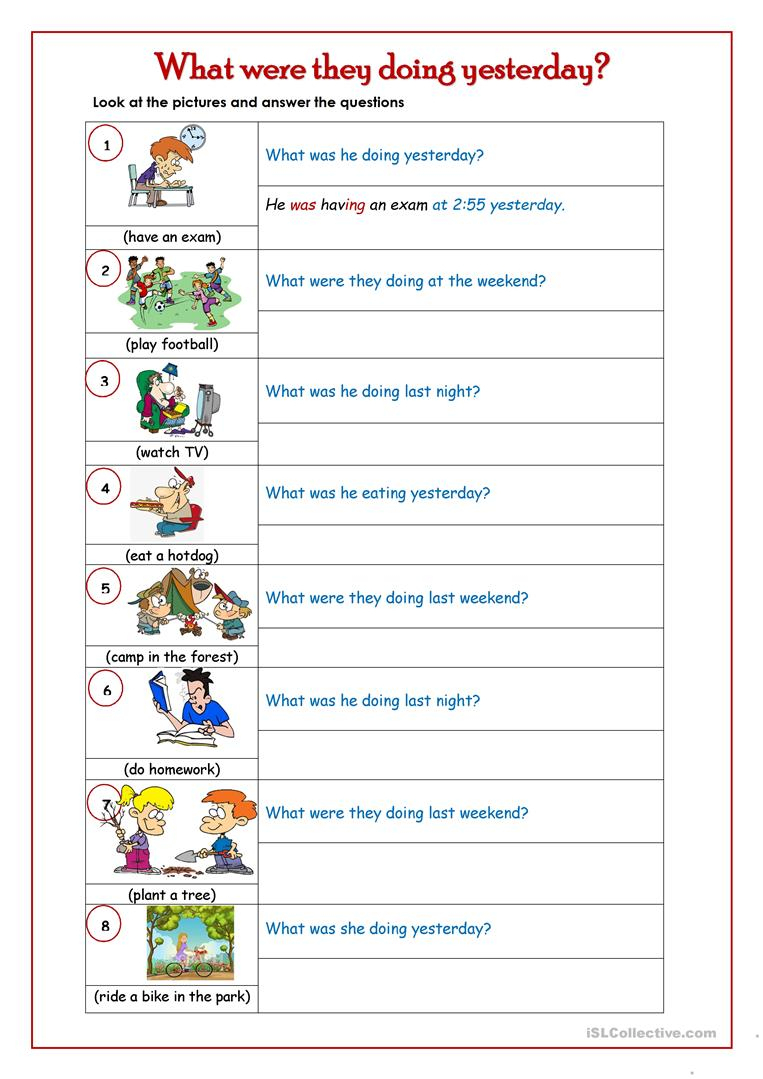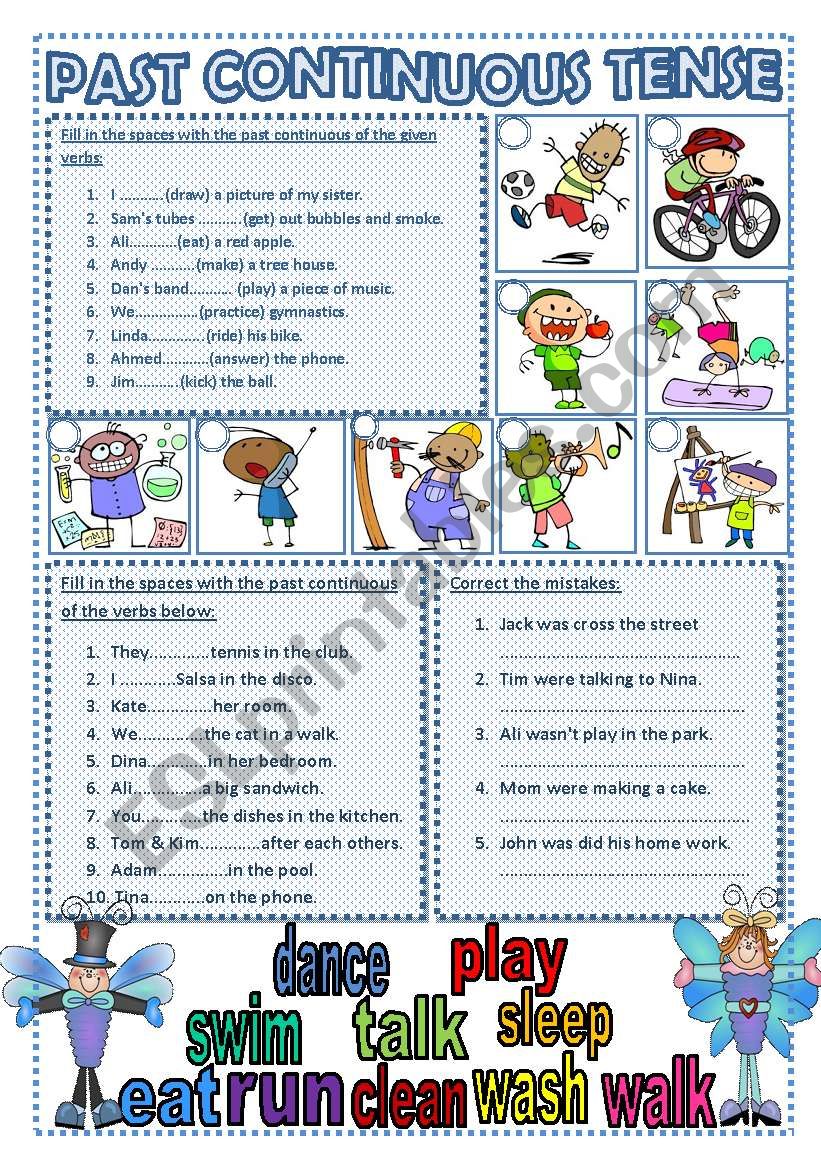
Mastering the Flow of Time: The Indispensable Role of Past Continuous Worksheets
The English language, with its rich tapestry of tenses, often presents a significant challenge for learners. Among these, the Past Continuous tense stands out as a particularly nuanced yet fundamental aspect, crucial for describing ongoing actions in the past, setting scenes, and understanding sequences of events. It allows speakers to paint a vivid picture of what was happening at a specific moment or over a period in the past. To truly grasp and confidently use this tense, a multifaceted approach to learning is essential, and at the heart of this approach lies the strategic deployment of Past Continuous worksheets.
Understanding the Past Continuous Tense: The Foundation
Before diving into the utility of Past Continuous worksheets, it’s vital to have a solid understanding of the tense itself. The Past Continuous, also known as the Past Progressive, describes an action that was ongoing or in progress at a particular time in the past. Its form is relatively straightforward: subject + was/were + verb (-ing form).

For example:

- I was reading a book. (An action ongoing in the past)
- They were playing football when it started to rain. (An ongoing action interrupted by another past action)
- While she was cooking, he was watching TV. (Two parallel ongoing actions in the past)



Key uses include:
- Actions in progress at a specific time in the past: At 8 PM last night, I was eating dinner.
- Interrupted actions: Often used with the Simple Past. I was sleeping when the phone rang.
- Parallel actions: Two or more actions happening simultaneously. While I was studying, my brother was listening to music.
- Setting the scene/background actions: Used in narratives to describe the general atmosphere or ongoing events before a main action occurs. The birds were singing, and the sun was shining as I walked into the garden.
- Repeated actions (often annoying): He was always complaining about something.



The theoretical understanding of these uses is the first step. However, translating this knowledge into active, accurate, and fluent usage requires consistent practice and application, which is precisely where Past Continuous worksheets become indispensable.

Why Worksheets? The Indispensable Role of Past Continuous Worksheets
In the journey to master any grammatical concept, worksheets serve as a cornerstone, bridging the gap between abstract rules and practical application. For the Past Continuous, they offer a structured environment for learners to:
- Reinforce Form and Structure: Repetitive exercises help students internalize the "was/were + -ing" construction, reducing common errors like forgetting the auxiliary verb or using the wrong verb form.
- Practice in Context: Worksheets provide sentences and short paragraphs that place the tense within meaningful contexts, allowing students to see how it’s used naturally.
- Identify and Correct Errors: Error correction exercises challenge students to actively think about the rules and apply them to fix mistakes, fostering deeper understanding.
- Build Confidence: Successful completion of exercises boosts a learner’s confidence, encouraging them to use the tense more frequently in speaking and writing.
- Assess Understanding: For educators, worksheets are excellent tools for gauging student comprehension and identifying areas that require further attention.
- Provide Independent Practice: They allow students to practice at their own pace, whether in a classroom setting or for self-study.
A Spectrum of Past Continuous Worksheets: Types and Their Pedagogical Value
The beauty of Past Continuous worksheets lies in their versatility. A well-designed curriculum will incorporate a variety of worksheet types to address different learning styles and target specific aspects of the tense:
-
Fill-in-the-Blanks: These are often the entry point, focusing purely on the correct grammatical form. Students are given a subject and a base verb, and they must correctly conjugate it into the Past Continuous.
- Example: She (read) __ a book yesterday afternoon.
- Pedagogical Value: Excellent for reinforcing the basic structure and building foundational accuracy.
-
Sentence Completion/Expansion: Students are given a partial sentence and must complete it using the Past Continuous, often with a provided verb or a choice of verbs.
- Example: While I was studying, my brother (listen) __ to loud music.
- Pedagogical Value: Encourages contextual understanding and the correct application of the tense within a sentence.
-
Error Correction: Students are presented with sentences containing grammatical errors (e.g., incorrect auxiliary verb, wrong verb form, misuse of tense) and must identify and correct them.
- Example: I was read a book when you called. (Incorrect: I was reading a book when you called.)
- Pedagogical Value: Promotes critical thinking about grammar rules and helps students recognize common mistakes.
-
Matching Exercises: This can involve matching sentence halves (e.g., "While she was cooking…" with "…the phone rang.") or matching sentences to pictures that depict ongoing actions.
- Pedagogical Value: Reinforces understanding of cause and effect, parallel actions, and visual association with the tense.
-
Question Formation and Answering: Students practice forming questions using the Past Continuous (e.g., "What were you doing?") and providing appropriate answers.
- Example: Question: What were you doing at 7 PM last night? Answer: I was watching a movie.
- Pedagogical Value: Develops conversational skills and the ability to retrieve and provide information using the tense.
-
"When/While" Practice: These worksheets specifically focus on the crucial relationship between the Past Continuous (for ongoing actions) and the Simple Past (for interrupting actions), using conjunctions like "when" and "while."
- Example: I (walk) __ home when I (see) __ an old friend.
- Pedagogical Value: Crucial for understanding the interplay between tenses and creating more complex, narrative sentences.
-
Picture Description: Students are given a picture (e.g., a busy street scene, a park) and asked to describe what people or things were doing in the picture.
- Pedagogical Value: Encourages creative application of the tense, builds vocabulary, and develops descriptive writing skills.
-
Story Completion/Creation: Students are given the beginning of a story or a series of prompts and must complete it using the Past Continuous to describe background actions or ongoing events.
- Pedagogical Value: Fosters narrative coherence, extended writing practice, and the ability to set a scene using the tense.
-
Multiple Choice: A classic format where students choose the correct Past Continuous form or the most appropriate sentence from a given set of options.
- Pedagogical Value: Quick assessment of understanding and reinforcement of correct forms.
Crafting Effective Past Continuous Worksheets: Design Principles
Whether you are a teacher designing your own materials or selecting from existing resources, several principles contribute to the effectiveness of Past Continuous worksheets:
- Clarity of Instructions: Ensure instructions are simple, unambiguous, and easy for learners to follow.
- Appropriate Level: Tailor the difficulty to the learners’ proficiency level. Begin with simpler exercises and gradually introduce more complex tasks.
- Variety: Mix up the types of exercises to keep students engaged and target different skills (form, meaning, usage).
- Contextualization: Present the tense in meaningful contexts rather than isolated sentences. This helps students understand when and why to use it.
- Scaffolding: Provide support for learners, such as verb lists or example sentences, especially for lower levels. Gradually remove this support as they progress.
- Answer Keys: For self-study or peer-checking, clear answer keys are invaluable.
- Visual Appeal: Use clear fonts, sufficient white space, and relevant images to make the worksheet inviting and less overwhelming.
Maximizing the Impact: Strategies for Using Past Continuous Worksheets in the Classroom
Simply handing out Past Continuous worksheets isn’t enough. Their effectiveness is amplified when integrated into a well-planned lesson:
- Pre-Activity: Before assigning the worksheet, review the Past Continuous tense, its form, and its uses. Provide clear examples.
- Clear Instructions: Go over the instructions for each section of the worksheet verbally, checking for understanding.
- Collaborative Work: Encourage students to work in pairs or small groups. This promotes discussion, peer learning, and reduces anxiety.
- Monitoring and Feedback: Circulate around the classroom, offering help, clarifying doubts, and providing immediate feedback.
- Review and Correction: Go over the answers as a class. Don’t just provide the correct answer; explain why it’s correct and address common errors.
- Follow-up Activities: Extend the learning beyond the worksheet. For instance, after completing a story completion worksheet, have students read their stories aloud or role-play parts of them.
Beyond the Basics: Integrating Past Continuous with Other Tenses
While focused practice with Past Continuous worksheets is crucial, true mastery comes from integrating the tense with others, particularly the Simple Past. The "when/while" structures are paramount here. Worksheets that provide mixed tense practice, requiring students to choose between the Simple Past and Past Continuous based on context, are incredibly valuable.
- Example: I (sleep) __ when the fire alarm (go off) __. (Answer: was sleeping / went off)
- Example: While she (cook) __, he (read) __ a newspaper. (Answer: was cooking / was reading)
These exercises push students to think critically about the duration and sequence of actions, which is essential for natural communication.
The Digital Age: Online Resources for Past Continuous Worksheets
The internet is a treasure trove of resources for educators and learners alike. Numerous websites offer free, printable Past Continuous worksheets and interactive exercises. Popular platforms include:
- ESL-Brains, ESL-Lounge, British Council LearnEnglish: These sites offer a wide array of downloadable worksheets categorized by grammar topic and level.
- Worksheet Generators: Some websites allow teachers to create customized worksheets by inputting vocabulary or grammatical structures.
- Interactive Online Quizzes: Many platforms provide instant feedback, making them ideal for self-study.
Leveraging these digital resources can save time for teachers and provide learners with a diverse range of practice opportunities beyond traditional printouts.
Common Pitfalls and How Past Continuous Worksheets Can Help Overcome Them
Learners often encounter specific difficulties with the Past Continuous, which targeted worksheets can effectively address:
- Forgetting "was/were": Students might write "I reading" instead of "I was reading." Fill-in-the-blanks and error correction exercises specifically target this.
- Incorrect Verb Form: Using the base form instead of the -ing form (e.g., "She was cook"). Repetitive conjugation practice helps solidify the -ing ending.
- Confusing with Simple Past: Misunderstanding when to use each tense. "When/while" exercises are specifically designed to clarify this distinction.
- Spelling Rules for -ing: Forgetting to double consonants (e.g., "runing" instead of "running") or drop the ‘e’ (e.g., "makeing" instead of "making"). Worksheets can include sections specifically addressing these spelling rules.
By providing focused, repetitive practice on these common trouble spots, Past Continuous worksheets serve as diagnostic tools and corrective mechanisms, guiding learners toward accuracy.
Conclusion
The Past Continuous tense is more than just a grammatical structure; it’s a tool that adds depth, context, and vividness to narratives. For learners to confidently wield this tool, consistent, varied, and contextualized practice is non-negotiable. Past Continuous worksheets, in their diverse forms, offer precisely this: a structured, effective, and accessible means for students to internalize the form, grasp the meaning, and master the usage of this essential tense. From foundational fill-in-the-blanks to intricate story creation, these worksheets are not merely supplementary materials; they are integral components of a comprehensive language learning strategy, paving the way for fluency and precision in English communication. Ultimately, the consistent and varied use of Past Continuous worksheets empowers learners to describe the unfolding past with clarity and confidence.
